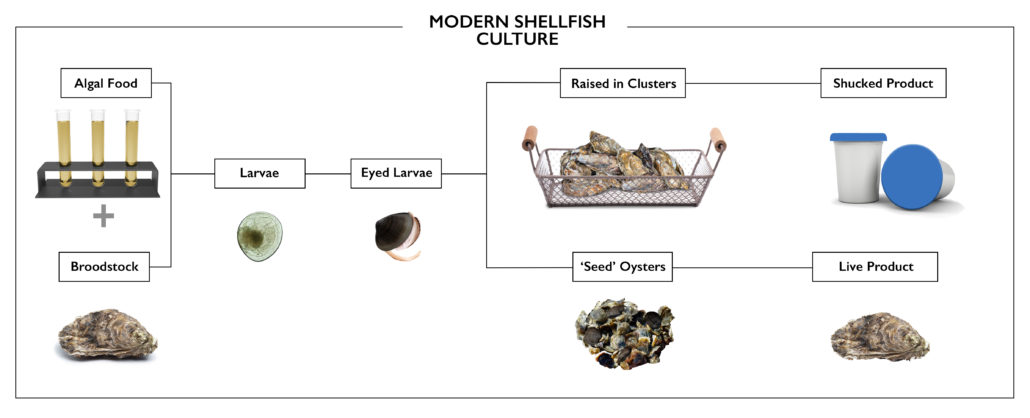SCIENCE AND TECHNOLOGY OVERVIEW
Oyster Lifecycle
The lives of wild and farmed oysters
When mature, wild adult oysters shed eggs or sperm directly into the sea and fertilization and early development are external. The free-swimming larva feeds on single-cell algae and eventually develops an eye-spot and a foot (see graphic below), with which it explores for suitable habitat, typically the shell of an adult, on which to settle. The larva undergoes a metamorphosis upon settlement, becoming a sedentary, filter-feeding juvenile.
This life-cycle can be completely controlled in modern shellfish culture
Adult “broodstock” are brought to maturity out of the normal reproductive season, by warming and feeding. Fertilization is controlled and the resulting larvae are reared in tanks to the “setter” stage. Setters are either sent to growers, who set them on mother shell and rear the oysters in clusters for their meats (shucked product), or are induced to undergo metamorphosis in the absence of setting to become single “seed” to be reared for the live, half-shell market.
Methods of Genetic Improvement
Two, alternative methods for the genetic improvement of farmed plants and animals, illustrated below, are based on two very different ways in which genes can influence or determine important production traits, such as yield (biomass produced per production unit or area).
The green curves below represent the frequency distributions of some trait of interest, such as yield, in various populations. Initially (upper left), the population shows a bell-shaped curve, meaning that most of the population has values close to the average and that values very different from the average are progressively rarer.
Crossbreeding
In the first method, selecting individuals from the upper tail of the distribution (above average, higher-yielding), as breeders of the next generation (upper left panel), yields a population of offspring (lower left panel), whose mean yield is now above the original average yield. Such an improvement implies that the parents passed genes, which conferred higher yield, to their offspring; in other words, the parents had higher “breeding values” than other individuals in their population.
Hybrids
In the second method of improvement, crossing inbred parent lines produces a population of hybrids, whose yield is much greater than that of the better parent line, a result known as “hybrid vigor.”
Pacific Hybreed specializes in the research, growth and development of crossbred, hybrid oysters. Production of hybrid oysters involves the crossing of inbred parent lines to create a variety of hybrid oysters. By tracking desirable traits, such as survival rate and yield, for a whole set of hybrids, we can determine the best hybrid combination and reliably reproduce that best hybrid by repeated cross breeding of its inbred parents. Subsequent testing of new hybrid combinations against the current best hybrid allows continual improvement in yield and resilience.
We can greatly accelerate the testing of hybrids by using biomarkers that predict yield based on the metabolic efficiencies of early larvae or seed [link to Resources/Physiological basis of hybrid vigor and resilience].
Polyploidy
An oyster’s or clam’s genetic makeup, like all other plants and animals, comprises two sets of chromosomes, one inherited from its mother and the other inherited from its father. Each chromosome set contains a complete set of DNA instructions for normal development, which coupled with environmental factors, determine how an organism lives, grows and reproduces.
Some animals and plants are polyploid, carrying three or more sets of chromosomes. In agriculture, including shellfish aquaculture, triploids, carrying three sets of chromosomes, are often desirable because they are reproductively sterile or seedless. Sterile shellfish, in turn, use the energy normally diverted to reproduction for growth, resulting in triploid oysters with larger and fuller meats.
Supporting Pacific Hybreed’ sustainability goals, triploid organisms pose zero risks of contaminating wild local populations as they cannot reproduce.
Genomics
Nearly complete DNA sequences of the human genome were first published in February 2001, launching the modern era of genomic sciences and transforming medicine and biology. Pacific Hybreed founder Dennis Hedgecock co-authored the publication of the Pacific oyster genome in 2012 [link to resources?] and has developed genome-based tools for discovering and mapping genes of interest to oyster aquaculture [link to Resources/Genomic approaches and tool development]. Genomic tools can greatly accelerate breeding programs.


